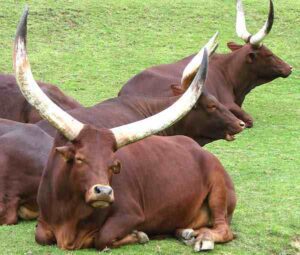The Kuri cattle are a multi-purpose breed of cattle which are used for milk and meat production and also for work. It is a breed of the humpless longhorn group of cattle.
The breed is found on the shores and islands of Lake Chand and it’s main habitat is southern Chand and north-eastern Nigeria. But it is also found in northern Cameroon, in Niger and to a limited extent in the Central African Republic.
The Kuri cattle are also known by some other names such as White Lake Chand, Kuburi, Dongolé, Chand, Boudouma, Budumu, Budduma, Baharié, Kouri etc.
The gigantic bulbous horns are an unmistakable trait of the Kuri cattle. These animals are believed to have descended from the Hamitic Longhorn cattle and have been herded by the Buduma and Kuri peoples for centuries.
They are very important animals in those areas where they are found. Their importance lies not only in their unique physical characteristics but also in their milk and meat production potentials.
They are so acclimatised to the environments of Lake Chand that they are unable to survive elsewhere. Number of this unique animal has decreased and it is being threatened by extinction. Read some more information about this cattle breed below.
Kuri Cattle Characteristics
The Kuri cattle are small to medium sized animals with a long back, shallow body and a large, bony rump. They are generally white in color. They have large, strong and bony with large, widely cleft hooves.
Both bulls and cows have horns. And their horns are gigantic which is an unmistakable trait of this breed. Horns of many of the animals grow in a lyre or crescent shape. Sometimes the horns reach 55 cm in diameter and 130 cm in length (most remarkable is the unique pear shape of the horns).
Average height of the bulls is about 150 to 180 cm, and 135 to 145 cm for the cows. Average weight of the cows is about 400 kg. And the bulls on average weight about 475 kg. But some bulls may reach about 600 kg. Info from ansi.okstate.edu.
Uses
Kuri cattle are multi-purpose breed of cattle. They are mainly used for milk production in their native area. But they are also used for meat production and for draught purposes.
Special Notes
The Kuri cattle are easily identified by their large horns. They are so acclimatised to the environments of Lake Chand that they are unable to survive elsewhere.
They are usually intolerant of heat and sunlight. And they also can’t stand long periods of drought. They are easily affected by the sun if unable to bathe. These animals are very good swimmers and generally spend much of their time in Lake Chand in search of water plant and food.
In their native area, they are kept mainly as a dairy cattle in herds of approximately 30 cows with one bull.
The Kuri cattle are generally docile and friendly in temperament. The cows are pretty good milk producers and they can produce about 4 liters of milk daily. However, review full breed profile of the Kuri cattle in the chart below.
| Breed Name | Kuri | |
| Other Name | White Lake Chand, Kuburi, Dongolé, Chand, Boudouma, Budumu, Budduma, Baharié, Kouri etc. | |
| Breed Purpose | Milk, meat, draught | |
| Special Notes | Docile, friendly, long horns | |
| Breed Size | Small to Medium | |
| Bulls | 475 kg | |
| Cows | 400 kg | |
| Climate Tolerance | Native climates | |
| Coat Color | Mainly white | |
| Horned | Yes | |
| Milk Yield | Good | |
| Rarity | Common | |
| Country/Place of Origin | Africa |






